Making Money Flow

In this article, we explore the long-term vision for Sablier.
We’re going to walk through the rationale behind the initial focus on continuous salaries and how we plan to leverage that in the future.
Tweaking the Mental Model
Employers shoot us a pay check once every so often — two weeks in the US and one month in Europe or Asia. This led society to imagine money as a collection of discrete payments.
We believe that makes for a highly inefficient payment system.
Salaries should be paid continuously and instantly available for employees to withdraw as they’re going to work.
When I arrived in the UK and started my job as a blockchain engineer at AZTEC, I had to open up my Compound savings account to pay for the following:
- First month of rent and an initial deposit as guarantee for the landlord
- Day-to-day costs
Ideally, I should’ve been able to withdraw a little bit of money once every so often to pay for my living costs and also redistribute a fraction of my incoming “stream” towards the landlord.
Humankind has been using cash and various other forms of physical money for so long that it got everyone entrenched in an archaic mental model.
Thanks to Ethereum and smart contracts, we can do better.
MONIAC
The Monetary National Income Analogue Computer (MONIAC) is a hydro-mechanical machine created in 1949 by Bill Phillips to model the economy of the United Kingdom.
He used water to portray the continuous flow of money — which is, in fact, money’s natural state.
Across salaries, consumer expenditure, investment funds and government spending, there’s only one property that gracefully connects all of them: time.
Time dictates people’s net worth. And tax duties. And interest rates. Why don’t we let it do its job?
Kudos to Bill and the Reserve Bank of New Zealand for envisioning Sablier before it was cool:
The Rise of the Stablecoins

Stablecoins such as MakerDAO’s DAI rose like a phoenix after the market crash of 2018.
They are one of the hottest trends in crypto — and rightly so, bringing the stability of fiat currencies to the digital world of blockchains will unlock a lot of untapped potential.
How are they different to fiat currency and why are they important to our goal of making money flow?
For one, the cost of settlement is stupendously low — we are international from day one and can do business across borders with almost no fee.
Then, the vast majority of people wouldn’t accept their salary paid in a volatile currency such as Ether or Bitcoin (there are of course exceptions).
At the moment, Sablier works with DAI, USDC and GUSD, but we’re looking forward to integrating with more stablecoins. Feel free to get in touch if you want to chat about yours!
The Sablier Economy
Inspired by MONIAC and capitalising on the rise of the stablecoins, the first chapter of the Sablier story will be about continuous salaries.
Our mission is to grant employees instant access to earnings as they’re going to work — everything done trustlessly via Ethereum smart contracts.
That said, for the long haul, the vision is a bit more nuanced.
Once salaries become streams, we can use them as collateral for other applications.
- Freelancing
- Subscriptions
- Taxes
- Consultancy (lawyers, doctors)
- Rent
- Car parking
Our ape CPUs would benefit immensely from using this kind of payment system.
We could abstract away recurring payments, as the Sablier smart contracts could automate and even net them out.
Let’s imagine the following scenario:
- Alice pays Bob every month
- Bob pays Carol every month
- Carol pays David every moth
- David pays Alice every month
Fiat money is not programmable and certainly not interoperable, so Alice, Bob, Carol and David all have to manage these recurrent payments manually now — or, if the local jurisdiction allows that, trust a bank with a direct debit.
With Sablier, there won’t even be 4 discrete payments, but rather only 1 stream that distributes the deposit to 4 people based on their pre-defined rate of payment.
This is particularly cool if everyone pays the same amount, because the stream becomes stale (i.e. nobody has to pay anyone else anymore) until one of the participants interrupts it.
For more discussions around chains of payments, check out this Twitter thread.
Reach Out
We hope you enjoyed reading about our long-term vision. We’d love to get in touch if you’re interested in what we’re doing!
- Website: https://sablier.finance
- Twitter: https://twitter.com/SablierHQ
- Telegram: https://t.me/sablier
- GitHub: https://github.com/sablierhq/sablier
If you want to get in touch personally, I’m on Twitter and Keybase.
Peace out ✌️


